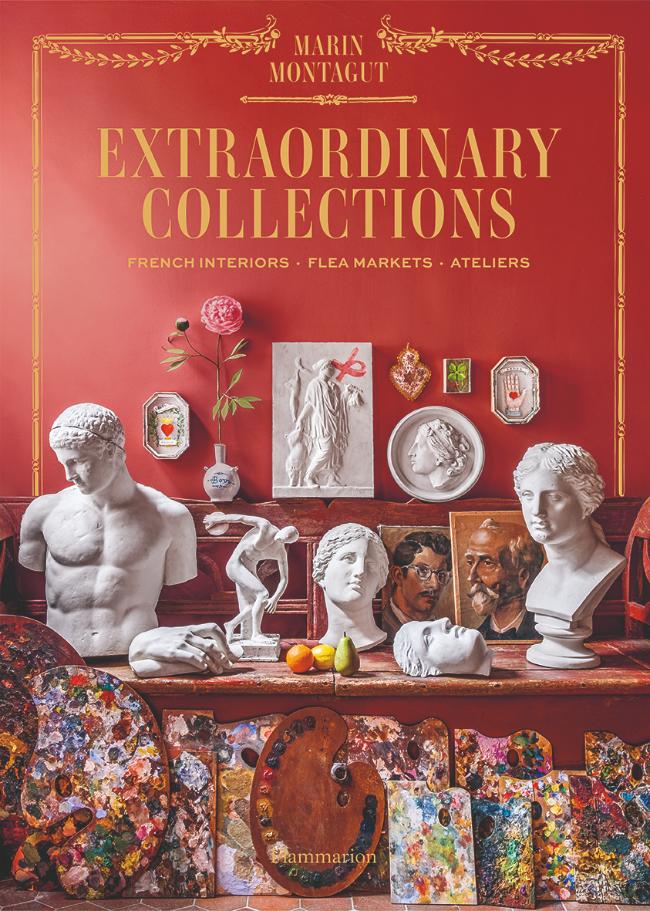An Extraordinary French Collection
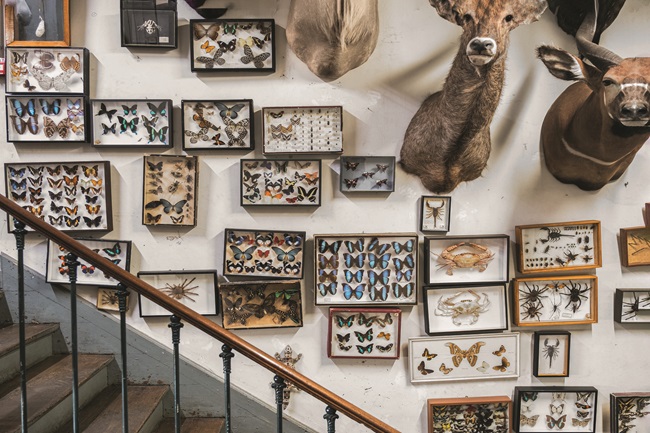
In his latest book, illustrator and designer Marin Montagut reveals how his passion for antique decorative objects began and leads us behind closed doors to discover two fabulous Parisian treasure troves.
My parents were antique dealers and my grandmother was an artist, so I grew up surrounded by by a multitude of objects of all kinds. As soon as I could walk, my parents began taking me to antique shops, flea markets, and even to auction houses. So, this taste for collecting is a family affair that has been passed down from generation to generation. In fact, many of my collections are connected to childhood memories. That’s true for the artists’ palettes I’ve accumulated; they have the power to take me back in time to my grandmother’s house, where I would spend hours watching her paint, fascinated by the colours and patterns that seemed to spring from her hands. Just looking at the palettes conjures up a multitude of abstract paintings, which bloom from the dappled paint on their surfaces.
Another of my favourite collections consists of plaster casts that find their way into my home, where they recreate the atmosphere of the artists’ studios that have always fired my imagination. I like to pose them on stands, where the light plays on their contours, or even on the floor, to emulate the ambience of a sculptor’s workshop.
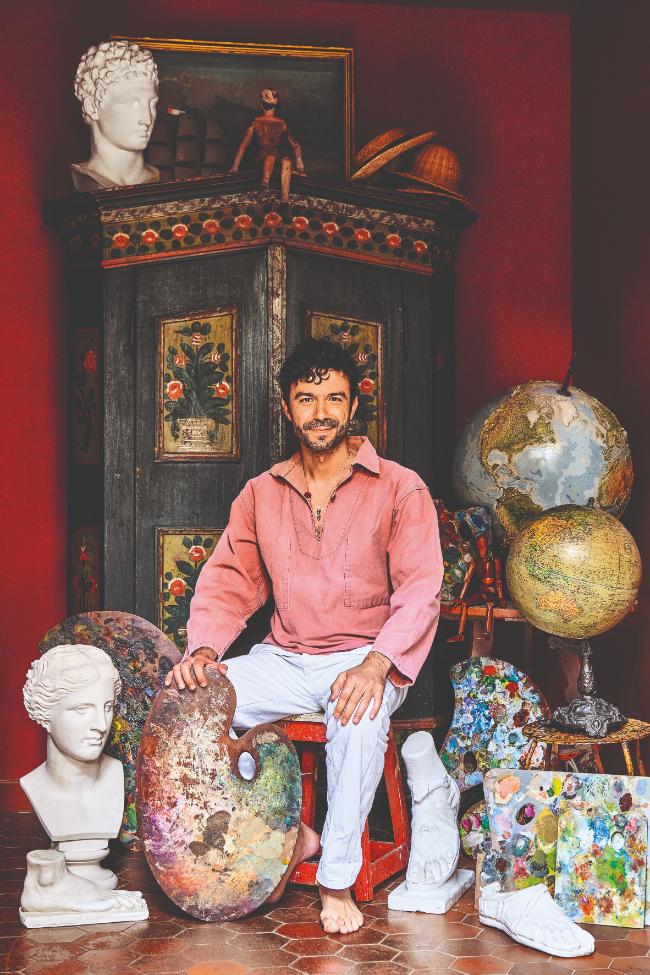
©Pierre Musellec
Finding objects endowed with soul is a passion that drives me every day. My mother’s antique store, Coco & Co, in Honfleur, is one of the places where I regularly discover treasures that I then find a place for at home. Whenever I travel, especially to Italy and Portugal, I always return with suitcases full of marvellous finds.
For my work as an illustrator and designer, they provide boundless inspiration. Each of my creations and watercolours says something about my world and my memories. From Italy, for example, I brought back silver ex-votos in the shape of a hand, face, foot, and heart, from which I had moulds made to reproduce them in porcelain. In Portugal, I was fascinated by registos, ancient reliquaries with painted and decorated frames of unimaginable refinement; they constitute without a doubt my biggest collection. I hung them together to create a wonder wall along the staircase that leads upstairs. They were my principal inspiration in creating my ‘window of wonder’ decorations. Interspersed among them on the wall are hearts that were once made by nuns using plain cardboard embellished with beads and embroidery. I’m overcome by their simplicity and beauty. Looking at them, I know that one day they will inspire me to make something new.
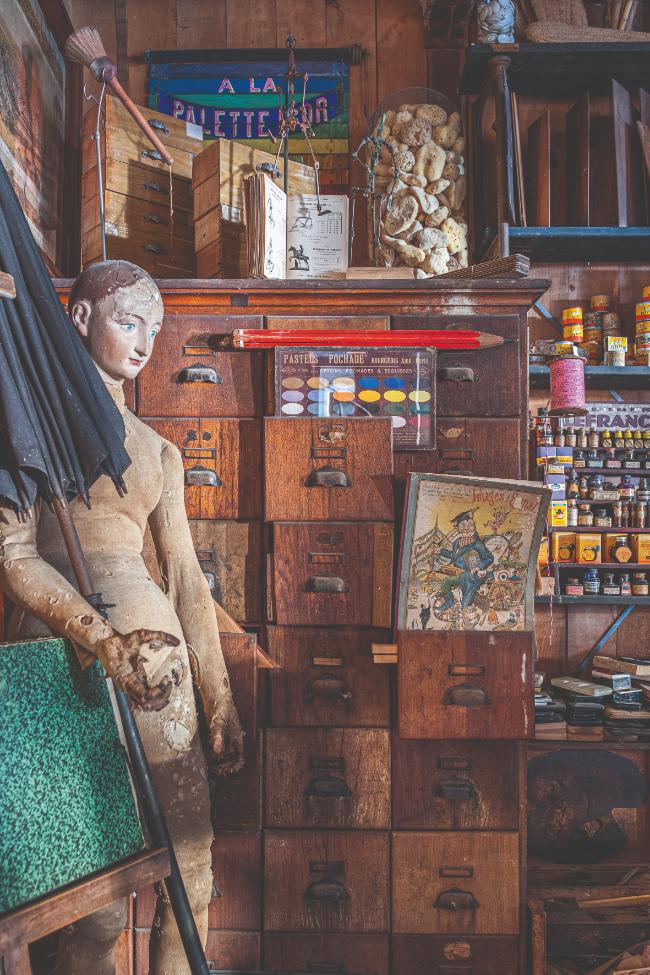
© Pierre Musellec
An open mind
When I go antiquing, I never approach it with a preconceived idea in mind. I rely on coincidence and luck. The unexpected, curiosity, surprise, and the joy of finding something: that’s what I look forward to on days when I head out in search of new gems to showcase in my house. At home, I wanted to reinvent the spirit of what the Germans call the wunderkammer, literally, ‘wonder room’. These rooms, which held collections of rare and unusual objects, were found in the castles and aristocratic homes of central Europe in the 16th century.
My ‘wonders’ are more modest, but they have the power to transport me elsewhere, and to inspire me. My interest in objects is not connected to their value. They are often humble tokens of everyday life and examples of folk art. I find them moving because they convey a soulfulness. The traces of passing time are visible on their worn surfaces. In them, I see history, heritage, and an expertise that has now been forgotten or lost. I even appreciate the flaws that make them unique, singular, like the flecks on a mercury mirror with pitted silvering, or the faded colours and patina of a piece of well-worn antique furniture.
Over the years, I have met many women and men, antique dealers and enlightened amateurs alike. Like a kid, I have been captivated, moved, enchanted and surprised by some of their collections. The idea for this book arose from those feelings and unique atmospheres. Turn the pages of this book and let your childlike spirit take you into the wonderful world of these extraordinary collections.
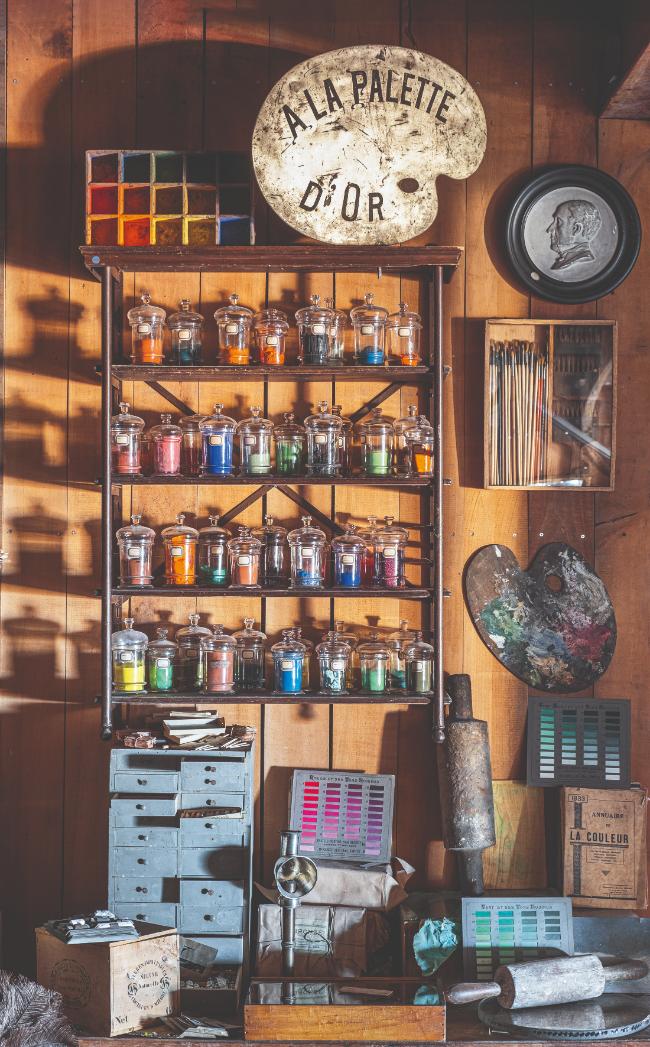
©Pierre Musellec
Museum of marvels
Grégoire Courtin is unrivalled when it comes to finding defunct businesses. In 2020, fortune smiled on him twice. First, when he purchased the entire contents of La Palette d’Or, a hardware, brush and paint shop in Angers founded in 1820 by a certain Charles Peltier, which remained in activity until 1978: a treasure trove of over 10,000 brushes of all kinds, as well as artists’ brushes, sponges, paints, palettes and pigments. A few months later, he purchased the stock, dating from 1920, of Aux 100,000 Chapeaux, from Victor Danteaux, a milliner in the Sarthe, north-western France, whose family had offered clients a vast selection of styles since the 1870s.
It only took Grégoire two months to unpack the crates. It occurred to him that, rather than selling off these precious relics of bygone expertise, he could preserve their memory by opening a place that could conserve these old businesses. Established in a former hardware store, La Maison Courtin, a museum unlike any other, is open every weekend. Grégoire and his wife, Emmanuelle, welcome and astound visitors, who follow the curator himself on a journey through time, piquing all of the senses. And for those who are tempted to purchase a heritage brush or broom, the couple also runs a shop where, unlike in the museum, everything is for sale.
GRÉGOIRE COURTIN, COLLECTOR: HATS, BRUSHES, PIGMENTS
The son of an antiques dealer and an antiques dealer himself, Grégoire Courtin fell under the spell of second-hand shops and flea markets at a tender age. In another life he owned a restaurant in Tours; he has since settled in La Chartre-sur-le-Loir to return to his first love. Every room in the house is full of objects that speak to the imagination, including an old artist’s mannequin said to have belonged to Edgar Degas, and a wonderful collection of early 19th-century decorative motifs from a stucco manufacturer in Sarrebourg. Beneath a curving staircase, tailors’ dummies with narrow waists and full hips evoke fashions of the past, while plaster casts from a factory in Champagne line the shelves.

©Pierre Musellec
Treasures for rent
The factory, founded in the 1930s by Gaëtan Lanzani, an Italian who settled in Paris near Faubourg Saint-Antoine, initially reproduced and restored period furniture and seating. After the war, the film industry turned to the Lanzani business for set supplies. Over the years, the establishment gradually abandoned the manufacture and restoration of furniture and began specialising exclusively in renting. When decorators and designers come to Lanzani nowadays, they know they’ll find what they’re looking for. Whether it’s a 1900s bed frame, a wicker basket, or a chest of hat boxes and leather suitcases evoking the past, they are sure to find the piece they need.
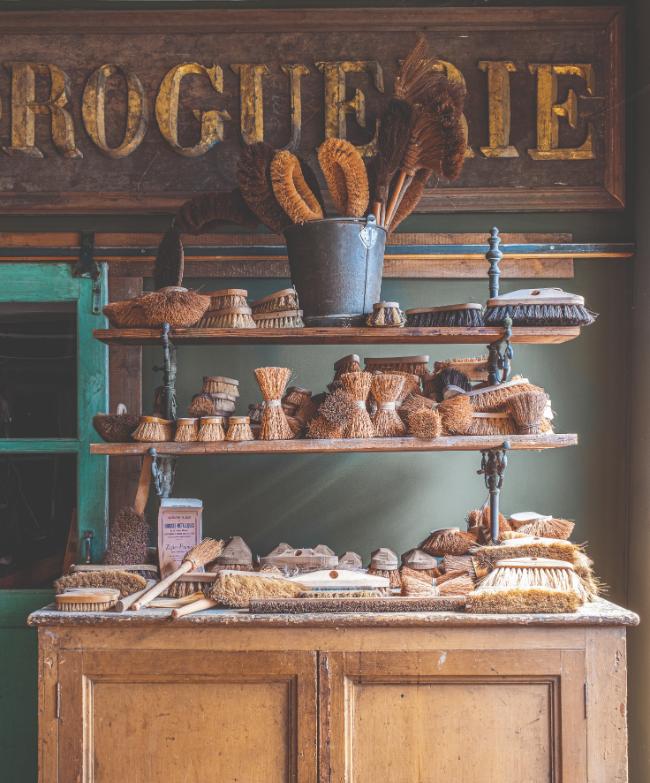
©Pierre Musellec
GAËTAN LANZANI, PROP AND SCENERY RENTAL: CHAIRS, DECORATIVE ITEMS, FURNITURE
Open the door to the courtyard of the establishment Gaëtan Lanzani and enter an unexpected world, a constantly changing cornucopia, where everything is for rent and nothing is for sale. Designers and decorators come here for a wide variety of furniture and accessories for movies, television, fashion shows, and other events. Here, professionals have access to more than 20,000 objects. You can find anything, from everyday items to the most surprising objects, fit for any curiosity cabinet.
Upon entering, visitors are greeted by a vulture with outstretched wings suspended above the entrance stairway. Hanging on the walls, stuffed animal heads, framed by dozens of cases of mounted butterflies, call to mind a natural history museum. A warren of staircases leads to a maze of corridors within a 32,000ft² (3,000 m²) labyrinth that holds an inventory the Surrealists would covet. The most astonishing collection comprises hundreds and hundreds of chairs, piled together and stacked to the ceiling. There are armchairs of all sorts: wingbacks, cabriolets, marquises, toi et moi’ or ‘confidant’ chairs, squat ‘crapaud armchairs, club chairs; chairs made of wood, rattan or cane; some of them upholstered with leather, or embroidered or brocaded fabrics, or velvet. There are even some untreated wooden chair frames. This incredible assortment echoes the location’s original function as a furniture manufacturing factory.
From France Today Magazine
Extraordinary Collections, Marin Montagut
Extracted from Extraordinary Collections: French Interiors, Flea Markets, Ateliers by Marin Montagut (Flammarion, 2023)
Lead photo credit : © PIERRE MUSELLEC
Share to: Facebook Twitter LinkedIn Email
More in art, book review, Interior Design
Leave a reply
Your email address will not be published. Required fields are marked *

